
*
As one Julie Andrews-originated role faded into the Sunday sunset March 3, another took its place on Broadway. Goodbye, Mary Poppins! Hello, Cinderella!
Something more than a foot fetish was afoot at the Broadway Theatre where the new (and, lamentably, last) Rodgers and Hammerstein musical slipped on to The Great White Way. Maybe that should be “slippered.” When the 12-minute shoe-fitting contest finally surfaces, it’s more like a quaint nod to the ancient legend.
Cinderella is a show of old-fashioned charm and newfound magic. And at the curtain call, both were acknowledged when the creators joined the cast on the stage. The book writer, Douglas Carter Beane, arrived, brandishing a gigantic photograph of his composer and lyricist, Richard Rodgers and Oscar Hammerstein II. It couldn’t have been gigantic enough for this crowd. “A lot of people seemed touched by that,” Beane reflected later. “I suddenly felt this overwhelming rejoicing—like, ‘They’re here! They’re back!' It was a very exciting moment.”
Ted Chapin, as president and executive director of the Rodgers and Hammerstein Organization, is the prime mover in extending the Broadway lives of this theatrical team. Their last “new”-if-posthumous Broadway show came in 1996: State Fair, based on the same-named musical of 1945, their only original film musical. Cinderella is their only original television musical, debuting live on March 31, 1957, on the 14th anniversary of their very first Broadway opening—that landmark liftoff, Oklahoma! The first 90-minute special with Julie Andrews, directed by Ralph Nelson and stage-managed by Joseph Papp, was radically revised and remade for Lesley Ann Warren in ‘65 and Brandy in ‘97 and has been crying for a Broadway mounting ever since.
Lead producer Robyn Goodman, rallying a conglomerate of 15 other producing groups behind her, heeded the call to give R&H that extra Broadway inning. “I feel that it was a gift that was given to me,” she confessed, “and I’ve tried to treat it as such by putting together the best team that I could possibly find—and I think I did.”
Starting with Star: “When Ted first asked me about taking this score and developing it into a new musical, the first person I thought of was this little actress whom I had seen in a couple of things, and her name was Laura Osnes. Three years ago, before it was even written, I told her I was going to have a part for her in two or three years and she should hang on. And when I called her and I told her what it was, she screamed. I said, ‘It’s the marriage of the role and the actress.’ If you’re looking for Julie Andrews, there she is—Laura has beauty, grace and the voice like an angel.”
Osnes remembers that phone call well. At the time, she was in Florida. The once and future Cinderella was preparing to blast her way onto Broadway as Bonnie Parker in Frank Wildhorn’s Bonnie and Clyde. “Robyn said, ‘We’re doing Rodgers and Hammerstein’s Cinderella, and we have you in mind. Will you be in our readings?’ ‘Yes.’ I’ve been a part of it now for almost two years. It has been a fantastic journey.”
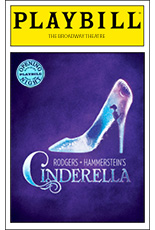
Buy this Limited Collector's Edition |
“That’s right,” he nods. “It was all drama at the Guthrie—no musicals, a lot of Shakespeare. I’d just done Hamlet when I came here. I was always singing on the side, of course, but I’d never done a musical. I was too busy doing Ibsen.”
But the songs are a definite attraction for him in this show—particularly a pair of evergreens R&H planted back in ’57: “Ten Minutes Ago,” an unfolding, enveloping waltz, and the haunting, searching “Do I Love You Because You’re Beautiful?”
Fontana admits a little reluctance about taking up his princely poses, but he says the script has made it easier than he imagined it would be. “I think Doug has combined a classic story with a very contemporary voice, but still there are some classic lines. Sometimes I feel like I’m in a Kaufman and Hart play because the lines are so earnest and you just have to go there. The Prince reminds me of the teenager in O’Neill’s Ah, Wilderness! who does that ‘God, I love you so much.’ He gets caught up in his own passion. But Doug has given me the freedom to play around with that.”
An actor even newer to the musical world is Greg Hildreth, the first person ever play to the woodsy rabble-rouser, Jean-Michel (the role never existed until this production). In fact, “More or less, this is my debut, showing that I can sing a little bit. I was in Bloody Bloody Andrew Jackson, but we really didn’t have to sing pretty for that. My song, ‘Now Is the Time,’ was cut from South Pacific but exists in some underscoring.”
Prior to this, Hildreth counted himself just an actor. In Peter and the Starcatcher, he was a ditzy deputy off whom Tony winner Christian Borle bounced his Captain Stash. Getting the girl is also a new phenomenon for him. “I’m always the unlikely one.”
The girl in this case is Gabrielle, Cinderella’s good sister—another break with the storytelling tradition but one that exists in Charles Perrault’s original 1691 French yarn. This twist in expectations is what drew Marla Mindelle to the part. “She’s a true three-dimensional character, I believe—shy and quirky and neat. She brings a heart and joy to the show. She’s not evil, which everyone expects. In other versions, the sisters were a gang of two—trouble and mean and nasty to Cinderella. I do like the fact I try to help her in this version.” She also helps her with a reprise of “A Lovely Night” and joins her Jean-Michel for another round of “Now Is the Time.”
| |
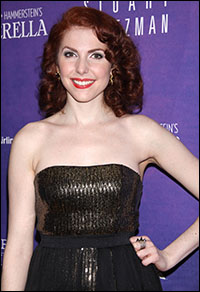 |
|
| Marla Mindelle | ||
| Photo by Joseph Marzullo/WENN |
Given Gabrielle’s defection to the side of the angels, Ann Harada’s Charlotte is left holding the bag of nastiness all by her five-foot self. This change alters the punctuation of the second-act curtain-raiser—“Stepsister’s Lament” instead of “Stepsisters’ Lament,” allowing Harada to lead the other hoop-skirted lasses in berating the mysterious interloper who had just made off with the prince’s heart.
“It’s one of the classics of that score, and to be able to sing that song is really a thrill,” she says. “I love doing it. The first time we did it in front of people, it got applause right in the middle—and we were, like, ‘Oooooo! We’re singing the hit!’”
She is also the lucky recipient of some of Beane’s most bracingly contemporary wisecracks. “Ann Harada, who I like to call Ann Erota, had a nerve to say to me one time when I cut one of her lines that wasn’t working, ‘Doug, they don’t all have to be ding-dongs.’ That’s what gave me the idea. I went, ‘What if I wrote a part, and every line was a ding-dong?’ So I wrote this part for her. Every time she speaks—if it didn’t get a laugh, I’d cut it—so every time she speaks now she gets a big laugh.”
Beane says the role that was the most fun for him to write—for personal reasons—was the mean-spirited, pretentious stepmother. “Well, Madame is based on my Grandma Carter. She was bipolar, let’s say, so I loved the idea of putting that on stage. One moment she’s funny and nice, and then she’s a horror. She was big on ripping.” Behind the withering wit lurks, perhaps, his own August: Osage County.
| |
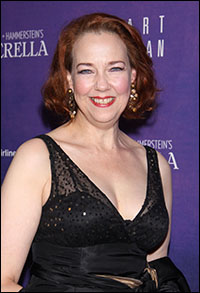 |
|
| Harriet Harris | ||
| photo by Joseph Marzullo/WENN |
Harada and Harris are both keen on their co-stars. “Isn’t it Murderers’ Row?” says the former. “That’s how I think of it. ‘If I don’t get that laugh, you’re going to get it.’”
Harris feels the company has come together and strengthened in the playing of the piece. “That’s just a thing of balance that happens from week to week. There are things that have come into focus more. I’m sure the relationships are stronger than they were because we didn’t do this out of town. We’re doing this in front of New York. I think they knew they had a great book and a great design concept, but it does mean we needed these 40 previews to have a chance to solidify the relationships.”
Harris and Peter Bartlett, who plays something of medieval Dick Cheney for the prince, form a funny, but fleeting, alliance only once—but they play the scene in exactly the same comic key, betraying a past of comic compatibility on stage. “Paul Rudnick has written two things that Peter and I were in together—Jeffrey and Rude Entertainment, and that was at a theatre Doug used to run. This is the third time I’ve worked with Peter, and it’s the third time I’ve worked with Mark Brokaw—and I hope it’s not the last that I work with either one of them because they’re great.”
| |
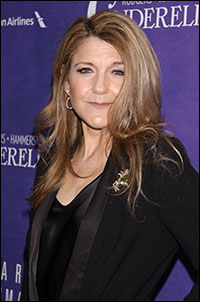 |
|
| Victoria Clark | ||
| Photo by Joseph Marzullo/WENN |
Bartlett’s depiction of a foppish power-figure will delight the producer out there plotting to revive a Cyril Ritchard vehicle. But he shows sterner-stuff when the prince starts seeing through his scheming ways. “I really made an effort to ground all of that material and make it real,” the actor admits. “It’s a genuine pleasure working with Santino. I’ve worked with so many young actors, and he’s a real joy.”
Victoria Clark, who last worked the Broadway Theatre as a Tony-nominated Mother Superior in Beane’s Sister Act, has been granted a major elevation. Here she is a fairy godmother who flings her bibbidy-bobbidi-boo gleefully about the stage, creating gorgeous ballgowns in seconds (sometimes three, never more than nine).
She also flies about with the greatest of (initially acted) ease. “In the beginning, I was frightened,” she has to admit. “They had to teach me—like, two feet off the ground, then they would raise it up and up till I got more comfortable. One time I’m on a swing, and the other time I’m in a harness, and neither time I have a safety wire on.”
She arrives on the scene disguised as a beggar-lady, looking less like Clark and more like character-actress Mary Beth Peil than Clark. “My own fairy godmother!” Clark exclaims, lighting up. “She’s one of my dearest friends. She brought my son into the world. She delivered him. It’s the truth. There were also doctors, but she was there.” Music is part of Clark’s magic act, and she isn’t short-changed in that department, what with “Impossible/It’s Possible” and the forgotten “There’s Music in You.”
But that particular song is not forgotten by Chapin, who knows where all the songs from other R&Hs are buried in this show. “There’s Music in You’ was written for the movie ‘Main Street to Broadway,’ one of the great terrible movies of all time. The song was a Rodgers and Hammerstein song that they wrote for Mary Martin to do in the new Rodgers and Hammerstein musical that Josh Logan is directing in the movie. Now I do have to say, even though that’s where it started, there’s been some help with that song to make it more of a power ballad. It was first done for Whitney Houston in the 1997 remake with Brandy, and then some more stuff was added.
“Santino’s first song, ‘Me, Who Am I?,' was cut from Me and Juliet, and ‘Loneliness of Evening,’ which Laura and Santino sing in the second act, comes from South Pacific.
| |
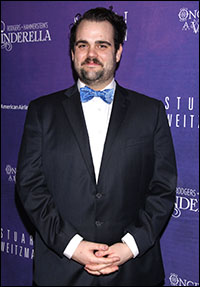 |
|
| Greg Hildreth | ||
| photo by Joseph Marzullo/WENN |
“What I think they’ve done really well in this production is that they’ve blended it all so it doesn’t feel like plopped-in songs from other places. It all feels like, to me, it all belongs here. David Chase is a wonderful musical supervisor. He took two songs from the Julie Andrews version—‘Your Majesties,’ which is a food song, and ‘The Prince Is Giving a Ball’—and figured out ways to use them in this production as transitional things so that’s why they’re there. They are very much a presence, but they’re used in a different way. Because it’s all Rodgers music, it all feels like it belongs.”
The secret star of Cinderella is the gifted and good-humored costume designer, William Ivey Long. Being a Southern boy, he says “Aw, shucks” to that.
So did he hear the applause when a few shakes here and there from a clever actress can trigger an entire dress transformation? “I did,” the designer drawls a little sheepishly. “It sorta stopped the show, didn’t it? But, y’know, that didn’t stop the show. What actually stopped the show was the fact that the audience was buying into our level of magic. That’s what it was. It wasn’t just one or two tricks. It was, they thought, ‘Oh. Okay. We’re on board.’ So it was for all of us, I feel.”
Long pioneered this little dress trick last season with Don’t Dress for Dinner, but this time he has the bucks and the inspiration. “Serving the Rodgers and Hammerstein cannon is the greatest thing you can do on earth. We’re not going to be able to do a Broadway debut of theirs ever again, so it’s an honor. With their music and with their lyrics, they—within an entire song—do more about character development and story telling than anything we do. What they do to create story and emotion is the greatest thing on the planet. To be a part of that is historic.
“Every transformation happens because the performer makes it happen. There is only one time when one hand pulls off a babushka and the tiara falls up. The rest is all done by the performers. There is no help whatsoever. You think about it. You draw pictures. And then you bring your A-plus team together. Then you really get to work. It’s not a village. It’s a town. I did it all, with my team. I have an excellent team.
“It’s the first time I said, ‘I’ll handle the magic.’ It’s hubris. You’re not supposed to say that. I’m not Siegfried and Roy—but I did it in honor of them and my training with them. I have to mention Siegfried and Roy, because they are my teachers. I did their last show at the Mirage. It ran 11 years—till The Tiger. And they are such humanitarians and animaltarians, and they’ve saved so many species. They’re bigger than life to me. You learn to take on magic which happens every day. There’s lightning or there’s rain, or there’s sun—it’s all magic, but you learn from Siegfried and Roy that life has magic in it, and you just sort of embrace it. That made me bold.”












































































































































